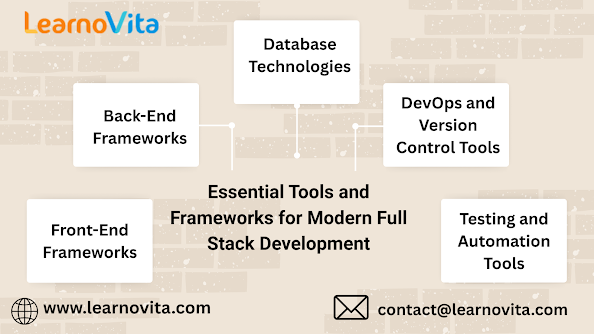From Frontend to Backend: Essential Tools for Full Stack Devs

The role of a full stack developer has evolved dramatically in recent years. Once defined by the ability to manage both front-end and back-end tasks, today’s full stack developers are expected to build fast, scalable, and secure applications that work seamlessly across platforms. Achieving that requires a well-chosen set of tools and frameworks that streamline development and boost productivity. Let’s explore the essential technologies that empower modern full stack development course in bangalore from the interface users see to the infrastructure running behind the scenes.
1. Front-End Frameworks: Creating the User Experience
The front end is the first impression users get of your product. It determines how intuitive and engaging the experience will be and the right framework can make all the difference. React.js, developed by Meta, dominates the front-end ecosystem. With its component-based structure, virtual DOM, and reusable code, React makes building dynamic and high-performing user interfaces efficient and flexible. Its massive community and ecosystem of third-party tools make it a dependable choice for any project. Angular, backed by Google, provides a more structured and opinionated approach. It’s ideal for large-scale applications that need maintainability and consistency. Features like two-way data binding, dependency injection, and TypeScript integration make it a comprehensive framework for enterprise-grade projects. For developers who value simplicity, Vue.js offers a lightweight yet powerful solution. With its approachable learning curve and flexible architecture, Vue is perfect for both quick prototypes and complex applications.
2. Back-End Frameworks: Running the Engine Behind the Scenes
The back end is where the logic lives managing user data, authentication, and APIs that connect with the front end. Node.js, paired with Express.js, is a popular JavaScript-based solution that allows developers to use one language across the entire stack. Node’s non-blocking architecture supports high performance, while Express offers a minimalist and efficient way to build scalable APIs. If Python is your language of choice, Django provides a full-featured framework designed for speed and security. It includes everything from an ORM to authentication tools, helping developers move quickly without sacrificing quality. Meanwhile, Spring Boot (for Java) is a trusted option for enterprise applications. Its microservice-ready architecture and built-in support for testing, security, and deployment make it ideal for large, production-level systems.
3. Databases: Structuring the Heart of Your Application
Data storage is the foundation of every application, and choosing the right database system is crucial for performance and scalability. For structured and relational data, MySQL and PostgreSQL remain industry standards. They’re reliable, easy to manage, and well-supported for transactional workloads. For projects that handle flexible, unstructured, or high-volume data, NoSQL databases like MongoDB and Cassandra offer the scalability and performance needed to manage complex datasets making them perfect for social platforms, analytics tools, and IoT systems.

4. DevOps and Deployment: Bridging Development and Operations
In modern full stack development online course, writing code is just the beginning deployment, automation, and scalability are equally important. Version control systems like Git, combined with platforms such as GitHub, GitLab, or Bitbucket, enable smooth collaboration and continuous integration (CI). For deployment, Docker has revolutionized the process by containerizing applications, ensuring consistency across environments. When paired with Kubernetes, developers can automate scaling, load balancing, and deployment orchestration efficiently. Cloud services like AWS, Microsoft Azure, and Google Cloud Platform (GCP) provide flexible hosting solutions and built-in DevOps tools that support CI/CD pipelines, monitoring, and scalability with ease.
5. Testing and Build Tools: Ensuring Quality and Speed
Testing is an essential step in maintaining quality and reliability. Frameworks such as Jest, Mocha, and Cypress help automate testing processes to identify bugs early and ensure stable performance. Meanwhile, build and bundling tools like Webpack, Babel, and Vite optimize performance by compiling modern JavaScript code, reducing load times, and improving browser compatibility.
Conclusion
Full stack development today is about adaptability being able to handle every layer of an application while keeping performance, scalability, and security in focus. By mastering these essential tools and frameworks from React and Node.js to Docker and Kubernetes developers can streamline their workflows and deliver high-quality applications faster. In an industry that’s constantly evolving, staying updated with the right technologies isn’t just an advantage it’s what sets great full stack developers apart. The future belongs to those who can connect all layers of technology into one cohesive, powerful experience.
- Questions and Answers
- Opinion
- Motivational and Inspiring Story
- Technology
- Live and Let live
- Focus
- Geopolitics
- Military-Arms/Equipment
- Security
- Economy
- Beasts of Nations
- Machine Tools-The “Mother Industry”
- Art
- Causes
- Crafts
- Dance
- Drinks
- Film/Movie
- Fitness
- Food
- Games
- Gardening
- Health
- Home
- Literature
- Music
- Networking
- Other
- Party
- Religion
- Shopping
- Sports
- Theater
- Health and Wellness
- News
- Culture

